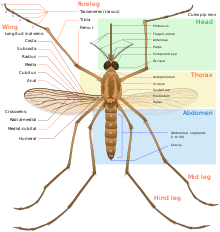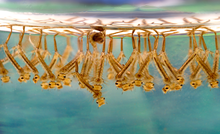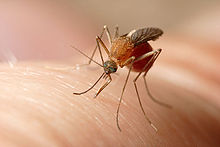Common mosquito
| Common mosquito | ||||||||||||
|---|---|---|---|---|---|---|---|---|---|---|---|---|

Common mosquito ( Culex pipiens ) |
||||||||||||
| Systematics | ||||||||||||
|
||||||||||||
| Scientific name | ||||||||||||
| Culex pipiens | ||||||||||||
| Linnaeus , 1758 |
The common mosquito or northern house mosquito ( Culex pipiens , Latin cúlex, -icis , "mosquito" and pipíre , "beeping") is one of the most common species in the family of mosquitoes ( Culicidae ) in Europe . There are around 100 species of mosquito in Central Europe .
features
The common mosquito has a 3 to 7 millimeter long, slender body, narrow wings and long legs. The abdomen segments are banded in dark brown and white. The females have developed a long proboscis that they use to suck blood . Your abdomen is rounded. The males have only one proboscis with which they ingest nectar and plant sap. They have feathered antennae .
Occurrence
The common mosquito is common worldwide.
Way of life
The females feed on the nectar and blood of mammals and birds , the males only on nectar and vegetable juices. After mating, the female needs proteins that she can only get by ingesting blood; so blood is necessary for reproduction. Mosquitoes perceive body heat, exhaled water vapor, carbon dioxide (CO 2 ), the odor of sweat and other animal and human odors. This is how they can find their hosts. A study has shown that mosquitoes respond particularly to the substance para-cresol in sweat. When the host is found, the compound eyes are also used to land . Mosquitoes often swarm in swarms, mostly made up of males. If a female joins the swarm, the males recognize this by the lower flight tone of the females (350 Hertz). The males literally pounce on the female. Together they sink to the ground, where mating takes place, which lasts only a few seconds.
Reproduction and development
Fertilized females overwinter in sheltered places (cellars, sheds). In the spring, 200 to 300 eggs are glued together and placed on the surface of the water as a floating boat. There are air bubbles between the eggs, which are lying close together, which prevent this raft from sinking even in the wind. Breeding grounds can be lakes and ponds, moats, swamp pools, rain barrels, puddles and even salty waters. However, highly eutrophicated waters are preferred, i. H. Waters with a good supply of nutrients. The larvae also survive prolonged lying dry. After hatching, they hang under the surface of the water with a breathing tube from the abdomen to the surface of the water. They feed on suspended particles, algae and small animals. In the event of a malfunction, they dive down for protection. The larva pupates after molting four times; instead of a breathing tube , the pupa has several breathing horns attached to the chest. It also hangs on the surface of the water as a doll, and the imago hatches after a short time . The whole development takes 20 days, but the duration also depends on the temperature. Natural enemies include fish and dragonfly larvae.
The species occurs in Europe in two types, which, depending on the author, are subspecies, form or ecotype. The form pipiens sucks blood on birds, the form molestus on mammals, preferably on humans. In 2016, researchers at the University of Vienna demonstrated that the two forms occasionally form hybrids , which means that avian diseases can possibly be transmitted to humans.
Course of a stitch
The female mosquito bites mainly at dusk and at night. It also invades apartments. After landing on a host, she waits a few seconds to make sure she hasn't been noticed. It has a skin site with an underlying blood vessel located, the ends of the are lower lip placed on the skin and their piercing-sucking mouthparts deep drilled. The pain is usually only slightly felt when the sting occurs, namely when the proboscis penetrating the skin hits a pain nerve and the victim notices the sting. The mosquito sucks up blood, causing its abdomen to swell and turn red. The saliva released into the wound liquefies the victim's blood and prevents the blood from clotting so that their proboscis does not clog while they eat. It also increases the flow of blood to the wound.
Itching / redness / allergies
The saliva released when stinging triggers itching in humans, and sometimes allergies . This itching is triggered by proteins that the mosquito injects with the saliva into the sucking point.
Mosquitoes as carriers of disease
Mosquitoes transmit pathogens because the saliva can contain viruses or bacteria that the animals ingested with blood when they had previously eaten from an infected host. The Sindbis virus and West Nile virus were detected in C. pipiens caught in Israel and Rift Valley fever in addition to the West Nile virus in animals caught in Egypt . It is not known whether they also transmit these diseases in principle. It has also been described that C. pipens can transmit the nematode Wuchereria bancrofti . Mild courses only lead to recurrent lymphadenitis and lymphangitis . Severe courses develop into filariasis , known as elephantiasis tropica. In 2010, Sindbis viruses were detected for the first time in Germany in C. pipens and two other mosquito species.
Control of mosquitoes
In residential areas, the regular emptying of rain barrels and the removal of small accumulations of water serve as protection against summer mosquitos. Defective rain gutters, lanes of cars on dirt roads, empty beverage cans, old car tires, septic tanks and fire extinguishers can be used by house mosquitoes as a habitat for larvae. There are various ways of preventing mosquitoes from multiplying in desired water supplies. Fly screens or mosquito nets that keep adult female mosquitoes away can help. In the evening outdoors, there is the possibility of loosely covering the skin and only treating the exposed areas with repellants . Insect repellent clothing can help where mosquitoes bite through clothing. In addition to some mosquitoes, UV lamps in the open also attract useful or endangered insects. So-called mosquito beeps, which generate high-frequency sounds and are intended to keep the mosquitoes away, are ineffective. Repellants applied to the skin have no long-range effect. They only provide short-term and comprehensive protection if they are applied over the entire surface of the exposed skin - otherwise even small untreated areas can be found by the mosquitoes and used to bite them.
Individual evidence
- ^ Erwin J. Hentschel, Günther H. Wagner: Zoological dictionary . G. Fischer, Jena 1996, ISBN 3-334-60960-X .
- ↑ Mixed form of the house mosquito can transmit diseases from birds to humans. Press release from the University of Veterinary Medicine, Vienna, April 26, 2016
- ↑ Systematic Catalog of Culicidae: pipiens Linnaeus . On: mosquitocatalog.org ; accessed on June 24, 2016.
- ↑ Hanna Jöst, Alexandra Bialonski, Volker Storch a. a .: Isolation and Phylogenetic Analysis of Sindbis Viruses from Mosquitoes in Germany. In: Journal of Clinical Microbiology. May 2010, Volume 48, No. 5, doi: 10.1128 / JCM.00037-10 , pp. 1900-1903.
- ^ Eva Scholl: Elaboration of guidelines for integrated pest control in the non-agricultural area (except wood pests). Environmental research plan of the Federal Minister for the Environment, Nature Conservation and Nuclear Safety / Research Report 126 06 011 - UBA I 4. 7, pp. 373–385: Appendix B-7 Mosquitoes. Weltersbach, July 1995 ( full text as PDF file ).
Web links
- Fam.Culicidae - Mosquitoes - Mosquitoes ( Memento from July 4, 2008 in the Internet Archive )
- www.insektenbox.de
- www.insektengalerie.de



